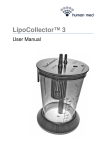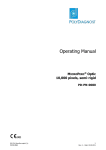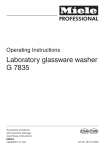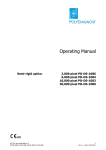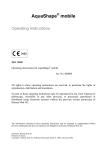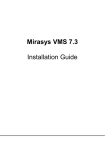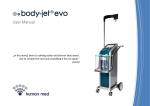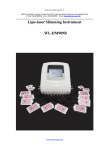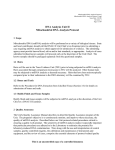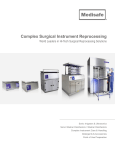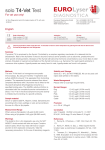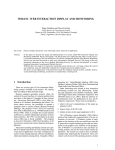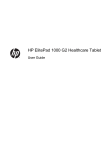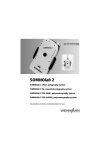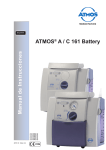Download Filler Collector User Manual
Transcript
FillerCollector™ User Manual Human Med AG Instruction on use and processing of the FillerCollector Doc No.: 900009 TM Page: 1 of 39 Rev./ Date: 0/ 21.06.2010 FillerCollector™ User Manual ISO 13485 Instruction on use and processing of the FillerCollector™, Ref no. US660000 All rights reserved, particularly the right to reproduce and distribute as well as translate this user manual. No part of this user manual may be reproduced in any form (by photocopying, microfilm or other procedures) or processed, copied or distributed using electronic systems without prior written consent of Human Med. FillerCollector™ is a registered trademark owned by Human Med AG, Schwerin, Germany. The technology used in Human Med’s products is protected by patents; further patents have been filed. The information contained in this user manual is subject to change or update without prior notification and Human Med assumes no liability for the contents of the information. Printed by: Human Med AG Printed in Germany Copyright © Human Med AG; Wilhelm-Hennemann-Straße 9, 19061 Schwerin; 2010 Human Med AG Doc No.: 900009 Instruction on use and processing of the FillerCollector TM Table of contents Page: 2 von 38 Rev./ Date: 0/ 21.06.2010 Table of contents I General description of the FillerCollectorTM 5 II Safety instructions 5 II. 1. Intended use 5 II. 2. Significance of the safety instructions 5 II. 3. Significance of the user manual, instruction of medical staff 6 II. 4. General safety instructions 6 II. 5. Compatibility information 7 II.5.1. 7 III Interface specification II. 6. Initial startup 7 II. 7. Disposal 7 Processing of the FillerCollector™ 9 III. 1. General information 9 III.1.1. Processing procedure 9 III.1.2. Selection of the reprocessing method 10 III.1.3. Control and checking 11 III.1.4. Recommended cleaning, disinfection and sterilization methods 11 III. 2. Workplace safety and health 12 III. 3. Preparation of reprocessing at the place of use 12 III. 4. Disassembly of the FillerCollector™ 14 III. 5. Manual cleaning and disinfection 15 III.5.1. Manual cleaning 15 III.5.2. Manual disinfection 16 III.5.3. Sterilization after manual cleaning 18 Human Med AG Doc No.: 900009 Instruction on use and processing of the FillerCollector TM Table of contents III. 6. III. 7. Page: 3 von 38 Rev./ Date: 0/ 21.06.2010 Automatic cleaning and disinfection 19 III.6.1. Automatic cleaning and disinfection 19 III.6.2. Sterilization after automatic cleaning 20 Information on validation of reprocessing 20 IV. Assembly of the FillerCollector™ prior to clinical use 23 IV.1. Components 24 IV.2. Assembly 25 V. Fat cell harvesting with the FillerCollector™ V.1. Functional principle of the FillerCollector™ 29 29 V.1.1. Internal pre-filtering by means of the FillerCollector™ basket 29 V.1.2. Gradual pressure reduction 30 V.1.3. Improvement of the aspirate quality 30 V.1.4. Amount of the collected aspirate and its liquid content 30 V.1.5. Fat extraction from the collection container of the FillerCollector™ 31 VI. Troubleshooting 33 VI.1. Lack of suction power owing to insufficient vacuum 33 VI.2. Localization and elimination of failures of system components 35 VI.3. Watery aspirate 37 APPENDIX Product list 2010 - USA Human Med AG Manual for use and processing of the FillerCollector Doc No.: 900009 TM Chapter I and Chapter II Page: 4 of 38 Rev./ Date: 0/ 21.06.2010 Contents I. General description of the FillerCollector™ 5 II. Safety instructions 6 II. 1. Intended use 6 II. 2. Significance of the safety instructions 6 II. 3. Significance of the user manual, instruction of medical staff 6 II. 4. General safety instructions 7 II. 5. Compatibility Information 7 II. 5. 1. Interface specification 7 II. 6. Initial startup 8 II. 7. Disposal 8 Human Med AG Manual for use and processing of the FillerCollector Chapter I and Chapter II I. Doc No.: 900009 TM Page: 5 of 38 Rev./ Date: 0/ 21.06.2010 General description of the FillerCollector™ The FillerCollector™ shall harvest the cell-liquid mixture suctioned off during water-jet assisted lipoplasty (WAL) and shall separate the preferably complete fat cells from the remaining liquid for laboratory purposes or autologous fat transfer. The amounts harvested by the FillerCollector™ under sterile conditions in a gentle and time-saving way, are comparatively small between 100 and 200 ml. The FillerCollector™ serves to filter lipocytes and connective tissue from the aspirate collected during water-jet assisted lipoplasty. The aspirate is firstly collected in the container. Owing to its physical buoyancy the cell material is floating on the liquid surface while the irrigation fluid is lead into the waste container. A special basket holds strands of connective tissue in the sterile collection container even if the suction power gets stronger. Compared to conventional procedures, this method of lipocyte harvesting represents a refinement and an ease of work. Human Med AG Doc No.: 900009 Manual for use and processing of the FillerCollector TM Chapter I and Chapter II Page: 6 of 38 Rev./ Date: 0/ 21.06.2010 II. Safety instructions II. 1. Intended use The FillerCollector™ is intended to be used for harvesting, filtering and transferring of autologous fat tissue during water-jet assisted lipoplasty. The device can be used in outpatient as well as inpatient surgeries. The prerequisite for optimal use of the product is a functioning suction equipment (e.g. body-jet®) suitable for WAL and the appropriate application system (WAL applicator). Human Med does not guarantee the quality of the autologous material collected by means of the FillerCollector™ and assumes no liability for any surgical procedure performed using the extracted material or their results. II. 2. Significance of the safety instructions This symbol characterizes a hazard that may cause personal injury. This symbol characterizes a hazard that may cause material damage. This symbol characterizes a hazard that may cause a failure or malfunction of the medical device. Please pay particular attention to the safety information in each chapter. II. 3. Significance of the user manual, instruction of medical staff Who needs to read the user manual? The user manual represents an important part of the product safety concept. Therefore, all those who will • • • • • prepare, set up, operate, dismantle, clean and disinfect the device must read the user manual and the instructions for use of the instruments. Only medical staff who has been trained in this procedure is allowed to use the FillerCollector™ in strict adherence to the present instructions for use. Human Med AG Doc No.: 900009 Manual for use and processing of the FillerCollector TM Chapter I and Chapter II Page: 7 of 38 Rev./ Date: 0/ 21.06.2010 Human Med assumes no liability for any damage resulting from improper use. In case of uncertainties, questions or suggestions please contact our customer service. II. 4. General safety instructions The FillerCollector™ and its accessories are only to be used under ambient conditions which guarantee the strict adherence to the surgical hygiene management. Dropping the lid or other heavy parts of the FillerCollector™ may cause injuries! Always handle with the greatest care and minimize the height of drop. Prior to first intended use a test run is necessarily to be made in a ‘normal’ liposuction, in which the aspirate can be discarded, since the surgeon’s technique may also affect the fat extraction and, therefore, may have to be adapted to optimize future results. Dropping or other vigorous application of force may damage the components of the FillerCollector™, which may potentially impair the functioning of the system. Always handle with care. Only original parts and accessories must be used. II. 5. Compatibility Information If the FillerCollector™ is not used in combination with the body-jet®, harvest-jet® or any other suction lipoplasty system manufactured by Human Med, an FDA cleared suction lipoplasty system including appropriate liposuction cannulae and connection tubing (FDA Product Code MUU, Regulation Number 21 CFR 878.5040) should be applied. The use of FDA cleared syringes (e.g. 50 cc syringes, Luer-Lock) and Luerto-Luer connectors is also recommended. II. 5. 1. Interface specification The tubing must be able to withstand the amount of negative pressure created by the pump without collapsing. Two kinds of connecting tubing are required: 1. The tubing that connects the liposuction cannula with the FillerCollector™ via the “PATIENT” connection port on the lid of the FillerCollector™, must have an internal diameter of 7 mm. Human Med AG Manual for use and processing of the FillerCollector Chapter I and Chapter II Doc No.: 900009 TM Page: 8 of 38 Rev./ Date: 0/ 21.06.2010 2. The tubing that transfers the waste solution from the FillerCollector™ via the “SUCTION” port on the lid of the FillerCollector™ to the waste container of the suction device must have an internal diameter of 4.8 mm and a length of 3 m. II. 6. Initial startup The FillerCollector™ is supplied as a set made up of several individual components. After checking that the packaging is undamaged and the content is complete, the disposable components labeled as sterile, are separated from the rest and stored. All reusable items must be cleaned and sterilized before their first use according to the processing instructions included in this user manual. II. 7. Disposal The FillerCollector™ can be disposed of at the end of its service life according to the national regulations related to the disposal of medical waste. Human Med AG Instruction on use and processing of the FillerCollector Doc-No.: 900009 TM Chapter III Page: 9 of 38 Rev./ Date: 1/ 23.08.2010 Content III. Processing of the FillerCollector™ 10 III. 1. General information 10 III. 1. 1. Processing procedure 10 III. 1. 2. Selection of the processing method 11 III. 1. 3. Control and checking 12 III. 1. 4. Recommended cleaning, disinfection and sterilization methods 12 III. 2. Workplace safety and health 13 III. 3. Preparation of reprocessing at the place of use 13 III. 4. Disassembly of the FillerCollector™ 15 III. 5. Manual cleaning and disinfection 16 III. 5. 1. Manual cleaning 16 III. 5. 2. Manual disinfection 17 III. 5. 3. Sterilization after manual cleaning 18 III. 6. Automatic cleaning and disinfection 19 III. 6. 1. Automatic cleaning and disinfection 20 III. 6. 2. Sterilization after automatic cleaning 21 III. 7. Information on validation of reprocessing 21 Human Med AG Doc-No.: 900009 Instruction on use and processing of the FillerCollector TM Chapter III III. Page: 10 of 38 Rev./ Date: 1/ 23.08.2010 Processing of the FillerCollector™ III. 1. General information III. 1. 1. Processing procedure The FillerCollector™ produced by Human Med is intended for being reprocessed after use. The admissible reprocessing methods are described in this chapter. In order to prevent the patient from infections, all components suited for processing must be reprocessed each time before use. The design and the material of the equipment only allow applying specific methods for reprocessing instruments. Disinfection or sterilization The Robert-Koch Institute (RKI) and the American „Centers for Disease Control and Prevention“ (CDC) as well assess those reusable medical products as critical that penetrate the skin or mucosa and thus come in contact with blood, inner tissues or organs. Among them there are also products through which body fluids are conveyed. In accordance with the RKI guideline we assess the FillerCollector™ as reprocessable without any particular requirements. After thorough cleaning, this product and its individual parts must be sterilized by steam sterilization prior to their application on the patient. The automatic cleaning and disinfection is to be preferred. Factory-new, unsterile parts of the FillerCollector™ are to be treated like used products. They must necessarily be cleaned before disinfection and sterilization. Manual or automatic cleaning Both manual and automatic cleaning of the system components basically lead to satisfactory results. However, manual cleaning methods bear a certain risk of infection for the cleaning personnel. Automatic cleaning methods minimize this risk and, moreover, have the advantage of standardized and validated procedures. Recommendation: Automatic cleaning is always preferred to manual cleaning because the processes are always consistent. The local responsible for hospital hygiene is to be consulted when deciding on manual or automatic cleaning in a specific situation. Standards Human Med recommends respecting the US standard ANSI/AAMI ST35 „Good Hospital Practice: Handling and Biological Decontamination of Reusable Medical Devices“, as well as the RKI instructions „Anforderung an die Hygiene bei der Aufbereitung von Medizinprodukten“, recommendation Bundesgesundheitsblatt 44/2001 1115 – 1126. Local standards and provisions are to be provided by the local responsible for hospital hygiene. Human Med AG Instruction on use and processing of the FillerCollector Doc-No.: 900009 TM Chapter III Page: 11 of 38 Rev./ Date: 1/ 23.08.2010 Compatibility Human Med distinguishes between 2 types of compatibility: - micro-biological compatibility material compatibility Micro-biological compatibility The micro-biological compatibility signifies that the FillerCollector™ has been successfully reprocessed and sterilized using the methods described in this instruction. Material compatibility The material compatibility indicates that after using the agents prescribed no adverse effects on the material of the FillerCollector™ parts have been found to date (see also Material durability). Material compatibility doesn’t signify that a specific degree of germicidal effect can be guaranteed. III. 1. 2. Selection of the processing method The appropriate processing procedure should be selected according to the national hygiene-related provisions and local guidelines of hospital hygiene. Automatic cleaning and disinfection When selecting the disinfecting entity, please check whether - it is effectually certified and accredited (e. g. by DGHM or FDA or CE marked acc. to DIN EN ISO 15883); - it uses an approved program for thermal disinfection (at least ten (10) minutes at 93 °C (199.4°F) or A0 > 3000) if possible; - the used program includes a sufficient number of rinse cycles; - only sterile or low-germ (max. ten (10) germs/ml) and low-endotoxin (max. 0,25 endotoxin units/ml) water is used; - the drying air is filtered; - the disinfection machine is maintained and inspected regularly. When selecting the cleaning agent, please make sure that - it is principally suited for cleaning medical products; - the used chemicals are compatible with the product parts (see also Material Durability). Strictly adhere to the concentrations indicated by the producer of the cleaning agent. Manual cleaning and disinfection When selecting the cleaning agent and disinfectant, please make sure that: - they are principally suited for cleaning medical products; - a disinfectant is used which efficacy has been approved (DGHM listed, CE approval, FDA approval for USA); Human Med AG Doc-No.: 900009 Instruction on use and processing of the FillerCollector Chapter III TM Page: 12 of 38 Rev./ Date: 1/ 23.08.2010 - the used chemicals are compatible with the system components (see also Material Durability). Strictly adhere to the concentrations and reaction times indicated by the producer of the cleaning agents and disinfectants. Only use fresh solutions, sterile or low-germ (max. ten (10) germs/ml) and low-endotoxin (max. 0.25 endotoxin units/ml) water. Only use filtered air for drying. III. 1. 3. Control and checking All disinfection and sterilization procedures must be reviewed regularly. Biological indicators for monitoring the disinfection process are not available. Nevertheless, test strips can be used for testing the concentration of the disinfectant. The concentration must be tested daily to prevent the solution from being diluted until it loses its effectiveness. In order to control the sterilization, all sterilization procedures are to be regularly checked using an appropriate biological indicator. Cleaning and sterilization must only be carried out by trained staff in rooms specially designated for this purpose. III. 1. 4. Recommended cleaning, disinfection and sterilization methods The cleaning, disinfection and sterilization methods recommended herein have been thoroughly tested with the individual parts of the FillerCollector™. Manual cleaning and disinfection We recommend using the disinfectants Gigasept Instru AF and Cidex OPA. The effectiveness and compatibility of both disinfectants have been approved by an independent, accredited testing laboratory. Imperatively observe the instructions given by the disinfectant producer. The procedures described below are based on the standard DIN EN ISO 17664 „Sterilization of medical devices – Information to be provided by the producer for processing resterilzable medical devices“. Automatic cleaning and disinfection The basic suitability of all FillerCollector™ parts for an effective automatic cleaning and dis-infection has been approved by an independent accredited testing laboratory. The approval tests have been carried out using the disinfector LS 2000 (co. Hamo, with drawer cart and laparoscopy cart equipped with connection ports for lumina) programmed for NEUTRAL WASHING, and the cleaning agents deconex TWIN BASIC / TWIN ZYME with neutralizer deconex 64 NEUTRARADRY (Borer Chemie AG); as well as CIDEZYME® GI / ENZOL® enzymatic detergent (ADVANCED STERILIZATION PRODUCTS, Division of Ethicon Inc.) The parameters used are described in the section III. 6. 1. Automatic cleaning and disinfection. Human Med AG Doc-No.: 900009 Instruction on use and processing of the FillerCollector TM Chapter III Page: 13 of 38 Rev./ Date: 1/ 23.08.2010 Steam sterilization according to the fractionated vacuum method The sterilization is to be done at a sterilization temperature of min. 132 °C (269.6 °F), max. 138°C (280.4 °F), and at a sterilization temperature holding time of min. three (3) minutes, max. thirty (30) minutes in a steam sterilizer validated according to ANSI AAMI ISO 11134. III. 2. Workplace safety and health Prevention of infections and chemical burns Bodily particles of the patients and decontamination chemicals represent a hazard. Protective equipment is required for protection against dangerous chemicals and potentially infectious materials. During cleaning, disinfection or sterilization wear protective equipment comprising eye protection and face shield, moisture-resistant clothes as well as tight-fitting chemical-resistant gloves that have to be sufficiently long so that no skin areas remain un-covered. Always remove contaminated protective equipment before leaving the processing facilities. Toxic chemical fumes As protection against toxic chemical fumes, the disinfection and sterilization room must be ventilated sufficiently. Material durability Note: In order to clean the collection container only use cleaning agents recommended for cleaning of PSU plastics. Please contact the producer of the cleaning agent and disinfectant in this regard. Do not use cleaning agents and/ or disinfectants containing phenol, since these could damage the plastic parts of the Filler Collector™. Never use rinse agents. They cause stress cracks in the collection container and can shorten its service life. III. 3. Preparation of reprocessing at the place of use The reusable parts of the FillerCollector™ are to be prepared for the subsequent reprocessing immediately after they have been used, still in the operating room. When reprocessing medical products take care in working carefully according to the local safety regulations. Human Med AG Doc-No.: 900009 Instruction on use and processing of the FillerCollector TM Page: 14 of 38 Chapter III Preparation and transport Rev./ Date: 1/ 23.08.2010 Remove the rough surface soiling using a disposable cloth/ paper towel. Transport reusable product components from the place of use to the reprocessing facilities. The parts can be transported either dry or immersed in fluid. Contaminated parts are to be transported in containers in order to prevent the environment and personnel from potential contamination. When transporting dry, please ensure that no soilings can dry on the instruments. Do not use fixating agents or hot water (> 40°C/ 104 °F) since these promote the protein coagulation impairing the cleaning result. Close the container. The subsequent cleaning must begin within three (3) hours after use. If this time limit is exceeded, special measures are to be taken to achieve a proper cleaning effect. We recommend starting with reprocessing of the FillerCollector™ parts immediately after use. When transporting the instruments immersed in fluid, the cleaning must begin within one (1) hour after use. Saline is not suited for immersion. Risk of damage to the instruments! Reprocess the instruments immediately after use. The above indicated time limits for transport must not be exceeded. Never leave a used instrument overnight before reprocessing. If an instrument is left in dry condition for a longer period, heavy soilings may dry on, leading to encrustations that may be difficult to remove. Limitation of reprocessing Required auxiliary means Provided that the product is used as intended by the producer, the end of its service life is determined by normal wear and tear. All parts of the FillerCollector™ have been successfully tested for a thirty-time (30) reprocessing using the validated manual and automatic reprocessing procedures including sterilization. Further reprocessing beyond this number or other reprocessing procedures are in the user’s responsibility. Ultra-sonic cleaning bath, rinsing bath, cleaning bath and brushes 10 mm 5 mm Human Med AG Doc-No.: 900009 Instruction on use and processing of the FillerCollector TM Page: 15 of 38 Chapter III Rev./ Date: 1/ 23.08.2010 III. 4. Disassembly of the FillerCollector™ 2a A) Remove the suction pipe with connection port (1) from the lid (2) equipped with port for connection to patient (2a). 1 3 2 5 B) Pull the sealing plug (3) from the lid and dispose of it. 6 C) Remove the white sealing rings (4) from the lid and the connection port of the suction pipe and dispose of them. D) Carefully remove the basket (5) and the separation pipe (6) from the lid. 7 E) Take the collection container (7) out of the foot ring (8). 8 3 2a 1 2 4 4 7 6 5 8 The sealing rings and the sealing plug are single-use products and must not be reprocessed and sterilized. Their reuse may lead to loss of material elasticity and to contamination of the aspirate by silicone particles. That may cause allergic reactions of the patient and, therefore, is explicitly prohibited. Human Med AG Doc-No.: 900009 Instruction on use and processing of the FillerCollector TM Chapter III Page: 16 of 38 Rev./ Date: 1/ 23.08.2010 III. 5. Manual cleaning and disinfection III. 5. 1. Manual cleaning Prescribed cleaning agents When disinfecting with Gigasept Instru AF, also use Gigasept Instru AF for cleaning. When disinfecting with Cidex® OPA, use a low-foaming encymatic detergent of a neutral ph-value (6 - 8) for cleaning. We recommend using CIDEZYME GI or the enzymatic detergent ENZOL®. We advice against using strong acid or alkaline cleaning agents. Immersion of the parts for manual pre-rinsing All individual parts intended for reuse, as suction pipe with connection port, lid with port for connection to patient, basket, separation pipe, collection container and foot ring must be immersed in the cleaning and disinfectant solution mixed with lukewarm water (deionised if possible) for at least ten (10) minutes or longer in case of stubborn or dried-on soilings. The concentration is to be selected according to the producer’s specification. Manual pre-cleaning All individual parts must be pre-cleaned in the cleaning solution using brushes. This work must be repeated until the brushes and the surfaces and hollow spaces to be cleaned are free of visible contamination. After cleaning rinse all parts with potable water. Manual cleaning Afterwards, all parts must be completely immersed in an ultrasound bath with cleaning and disinfectant solution (mixed with lukewarm water, deionized if possible). They must stay in the ultrasound bath for at least five (5) minutes. As an option, they can also be cleaned in an immersion bath with the same lukewarm cleaning solution for fifteen (15) minutes. The concentration is to be selected according to the producer’s specification. Do not mix with other cleaners! After cleaning rinse all parts with deionized water (aq. dest.). Cleaning check Finally check all surfaces, ports and hollow spaces for visible contamination. Return contaminated parts to the cleaning process. Infection control risk by cleaning agents Using unsufficient cleaning agents can provoke an infection control risk. Only use cleaners that are approved in accordance with national hygiene-related regulations and local guidelines. Human Med AG Doc-No.: 900009 Instruction on use and processing of the FillerCollector Chapter III TM Page: 17 of 38 Rev./ Date: 1/ 23.08.2010 Risk of damage due to incompatible cleaning agents Incompatible cleaning agents can cause considerable damages to the Filler Collector™. Therefore, only use cleaners approved by Human Med. Risk of damage due to residues of cleaning agents In order to remove all residues, thoroughly rinse every part with deionized water (aq. dest.) in the last rinse cycle. Do not use tap water for the last rinse cycle. III. 5. 2. Manual disinfection Prescribed cleaning agents a) Gigasept Instru AF (co. Schülke & Mayr) concentration/ contact time: 3 % – 15 min., 2 % – 30 min., 1,5 % – 60 min. Maximum period of use: 7 days In case of strong contamination we recommend renewing the solution earlier. b) II. Cidex® OPA Ortho-phthalaldehyde HL disinfectant solution Contact time: at least 5 min. (undiluted) Maximum period of use: 14 days In case of strong contamination we recommend renewing the solution earlier. Manual disinfection Procedure and concentration when using Gigasept Instru AF: Immerse the FillerCollector™ parts in the prepared solution (concentration acc. to the producer’s specification) for fifteen (15) minutes. There must not be any air bubbles on the parts of the FillerCollector™. Procedure and concentration when using Cidex OPA: Immerse the FillerCollector™ parts in the concentrated, undiluted Cidex OPA solution for five (5) minutes. There must not be any air bubbles on the parts of the FillerCollector™. In order to avoid damages, only use gripping pliers with rubber jaws when handling the instruments in the disinfectant solution. Rinsing After disinfection completely rinse all parts in a large volume rinse bath (at least 8 liters) for at least one (1) minute. Afterwards, flush all lumina of the lid as well as the suction pipe and the separation pipe by hand again. Dispose of the rinse water. Thoroughly rinse all parts with sterilized, deionized water (aq. dest.) to remove all toxic residues of the disinfectant. The rinsing of the parts is to be repeated twice as described. The sterile deionized water must be replaced after each rinse cycle. Human Med AG Doc-No.: 900009 Instruction on use and processing of the FillerCollector TM Chapter III Page: 18 of 38 Rev./ Date: 1/ 23.08.2010 Drying Maintenance Dry all parts internally and externally using sterile compressed air. The individual parts are not intendend for maintenance. Check and inspection Visually check the parts for damage and wear. Check the ports on the lid for deformation; the collection container for cracks, all stainless steel parts for corrosion. Reject any damaged part. Note If damaged parts shall be returned to Human Med or to an authorized supplier they must be cleaned, disinfected and sterilized before and be accompanied with the relevant documented evidence. Risk of unsufficient effectiveness of disinfection in small lumen parts When disinfecting small lumen parts, there is the risk that the inner lumen is not sufficiently in contact with the disinfectant solution. Therefore, the disinfectant solution must be injected into narrow lumina by means of a syringe. Risk of damage due to incompatible disinfectants Incompatible disinfectants can cause considerable damages to medical devices. Therefore, only use disinfectant solutions which Human Med has approved and released for use with the FillerCollector™. Risk of damage by exceeding the concentration and the contact time Strictly adhere to the instructions given by the disinfectant producer regarding the concen-tration and the contact time of the disinfectant solution. In order to prevent the device from damages, the indicated values must not be exceeded. Risk of damage due to residues of disinfectants Disinfectant solutions can contain various aggressive chemical ingredients (e. g. chlorine) that may cause corrosion of the product. Therefore, thoroughly rinse the product with de-ionized water (aq. dest.) to remove all residues. Do not use tap water for rinsing since it could be chlorinated. III. 5. 3. Sterilization after manual cleaning Packaging In accordance with ISO 11607 the dried FillerCollector™ parts must be packed in sterile packaging suited for steam sterilization as follows: - suction pipe with connection port together with separation pipe, - basket together with foot ring, - lid with port for connection to patient separately, - collection container separately. The packaging must be large enough so that the sealing is not subject to stress. Human Med AG Doc-No.: 900009 Instruction on use and processing of the FillerCollector TM Chapter III Page: 19 of 38 Rev./ Date: 1/ 23.08.2010 Sterilization Steam sterilization using a fractionated vacuum process at 121°C (250°F) for at least fifteen (15) minutes, and at 134°C (273°F) for three (3) minutes has been validated. Sterilization at 134 °C (273°F) for max. thirty (30) minutes has been tested; no adverse effects on the material of the Filler Collector™ have been detected. Prior to each sterilization procedure always check the batch process record for the respective sterilizer to ensure that the required parameters are being complied with. Storage The individual sterile plastic bags have to be stored in a closed cupboard, protected from dust and humidity and extreme fluctuations in temperature. The shelf life is determined by the product specifi-cations of the sterile packaging used. Active ingredients Gigasept-Instru AF: Cocospropylendiaminguanidiniumdiacetat, quaternary ammonium compound, benzyl-C12-16-alkyldimethyl,chloride, ethanol, tridecylethoxylat, propan-2-ol, N-dodecylpropan-1,3-diamine (this information is based on the producer’s specification) CIDEX OPA: Phthaldialdehyd (synonym: benzol-1,2-dicarbaldehyd) (this information is based on the producer’s specification) III. 6. Automatic cleaning and disinfection Prescribed cleaning agents The following cleaning agents are approved by the producer: a) deconex TWIN BASIC / TWIN ZYME and neutralizer deconex 64 NEUTRADRY (co. Borer Chemie AG) b) CIDEZYME® GI / ENZOL® enzymatic detergent (co. ADVANCED STERILIZATION PRODUCTS, Division of Ethicon Inc.) Only use cleaners that are approved by the producer for cleaning PSU plastics. Do not use cleaners containing phenol, since these could damage the plastic parts of the FillerCollector™. Never use rinse agents. They cause stress cracks in the collection container and can shorten its service life. Note If possible, the instruments are to be transported from the place of use to the reprocessing facilities in dry condition in order to avoid that protein can deposit due to the cleaning agent used. The water inflow into the washing machines must start at lower temperatures (approx. 20°C/ 68.0°F) to prevent thermal coagulation of proteins. Human Med AG Doc-No.: 900009 Instruction on use and processing of the FillerCollector TM Chapter III Page: 20 of 38 Rev./ Date: 1/ 23.08.2010 All individual parts intended for reuse, as suction pipe with connection port, lid with port for connection to patient, basket, separation pipe, collection container and foot ring must be put into the washing and disinfection machine. Recommendation When cleaning the lumen of the suction pipe, this is to be connected to the hose connectors of the washing and disinfection machine (preferably on the drawer cart of the machine). The same is to be done when cleaning the port for connection to the patient on the lid. We recommend using silicone hoses for the connectors of the washing and disinfection machine. III. 6. 1. Automatic cleaning and disinfection The following working steps are to be carried out when using a washing and disinfection machine. The procedure described below reflects the reprocessing as validated by Human Med. Automatic pre-cleaning Pre-rinse twice with 20°C (68°F) warm water for five (5) minutes each pre-rinse cycle. Automatic cleaning Cleaning with 55°C (131°F) hot water mixed with cleaning solution as specified by the cleaning agent producer (we recommend using deconex TWIN BASIC together with TWIN ZYME) and at a temperature-hold time of at least fifteen (15) minutes First rinse cycle With 10°C (50 °F) cold water for three (3) minutes Second rinse cycle With 20°C (68°F) warm, fully deionized water for three (3) minutes Blowing The cleaned parts are to be blown out at a temperature of 80°C (176°F) and a hold time of one (1) minute. Automatic disinfection Thermal rinsing with fully deionized water at a temperature of 93 °C (199.4°F) and a temperature-hold time of ten (10) minutes by adding the neutralizer deconex 64 NEUTRADRY (co. Borer Chemie AG), concentration: 1 ml/L Automatic drying Cooling At 70 °C (158°F) for at least fifteen (15) minutes The products cool down at 30°C (86°F). Human Med AG Doc-No.: 900009 Instruction on use and processing of the FillerCollector TM Chapter III Page: 21 of 38 Rev./ Date: 1/ 23.08.2010 Maintenance The individual parts of the FillerCollector™ are not intended for maintenance. Check and inspection Visually check the parts for damage and wear. Check the ports on the lid for deformation; the collection container for cracks, all stainless steel parts for corrosion. Reject any damaged part. Note If damaged parts shall be returned to Human Med or to an authorized supplier they must be cleaned, disinfected and sterilized before and be accompanied with the relevant documented evidence. III. 6. 2. Sterilization after automatic cleaning see section III. 5. 3. Sterilization after manual cleaning III. 7. Information on validation of reprocessing The following test instructions, materials and machinery have been used for validation of the cleaning process: Agent for automatic cleaning: deconex TWIN BASIC / TWIN ZYME, co. Borer Chemie AG Neutralizator for automatic cleaning: Deconex 64 NEUTRARADRY, Borer Chemie AG Agent for manual cleaning: Gigasept Instru AF, SCHÜLKE & MAYR Disinfectant for manual disinfection: Gigasept Instru AF, SCHÜLKE & MAYR Washing and disinfection machine: LS 2000, co. Hamo, with drawer cart (laparoscopy cart with ports for lumina) Program NEUTRAL WASHING Please contact Human Med for additional information on the validations. If the above described chemicals and machines are not available it is the user’s responsibility to ensure validation of the reprocessing method used. It is the reprocessor’s responsibility to ensure that the reprocessing actually performed with equipment, materials and personnel in the reprocessing facility achieves the desired result. This requires validation and routine monitoring of the process. Likewise, any deviation from the instructions provided must be properly evaluated by the reprocessor for effectiveness and potential adverse consequences. Human Med AG Doc-No.: 900009 Instruction on use and processing of the FillerCollector TM Chapter III Page: 22 of 38 Rev./ Date: 1/ 23.08.2010 List of tested cleaners and disinfectants, particularly suited for cleaning and disinfection of the collection container Trade name Producer Remarks Automatic cleaning Thermosept RKN-zym Thermosept alca clean SCHÜLKE & MAYR SCHÜLKE & MAYR Enzymatic detergent Alkaline cleaner containing tensides, possible ph-value > 10 Neodisher Mediclean forte CIDEZYME® GI / ENZOL® enzymatic detergent Manual cleaning Gigasept Instru AF CIDEZYME® GI / ENZOL® enzymatic detergent Manual disinfection Gigasept Instru AF Neodisher Septo 3000 DR. WEIGERT ADVANCED STERILIZATION PRODUCTS Enzymatic detergent SCHÜLKE & MAYR Aldehyde-free ADVANCED STERILIZATION PRODUCTS Enzymatic detergent SCHÜLKE & MAYR Aldehyde-free DR. WEIGERT ADVANCED STERILIHigh level disinfectant for CIDEX OPA ZATION PRODUCTS semi-critical medical devices Two-component cleaning system for automatic cleaning TWIN BASIC Neutral enzymatic and mild Borer Chemie AG TWIN ZYME alkaline Human Med AG Instruction on use and processing of the FillerCollector Chapter IV Doc-No.: 900009 TM Page: 23 of 37 Rev./ Date: 2/ 01.11.2010 Content IV. Assembly of the FillerCollector™ prior to clinical use 24 IV. 1. Components 25 IV. 2. Assembly 26 IV. 3. Attachment of the suction tube and the connection tubing 27 Human Med AG Doc-No.: 900009 Instruction on use and processing of the FillerCollector Chapter IV TM Page: 24 of 37 Rev./ Date: 2/ 01.11.2010 IV. Assembly of the FillerCollector™ prior to clinical use Visually check the FillerCollector™ parts for damage and wear. Do not assembly if any individual part shows damages. The complete FillerCollector™ is to be assembled under aseptic conditions using the supplied sterile single-use parts (extraction cannula, sealing rings for lid and connection port of the suction pipe, sealing plug). After sterilization all FillerCollector™ parts must cool down sufficiently (below body temperature) before they can be used. Human Med AG Doc-No.: 900009 Instruction on use and processing of the FillerCollector TM Page: 25 of 37 Chapter IV Rev./ Date: 2/ 01.11.2010 IV. 1. Components I E H A D J G C F B Legend: A B C D E F G H I J Collection container Foot ring Basket Sealing ring for lid Lid of the collection container Separation pipe Suction pipe Connection port of the suction pipe Sealing plug Sealing ring for the connection port of the suction pipe Human Med AG Doc-No.: 900009 Instruction on use and processing of the FillerCollector Chapter IV TM Page: 26 of 37 Rev./ Date: 2/ 01.11.2010 IV. 2. Assembly Step 1: A Put the collection container (A) into the foot ring (B). B Step 2: E D Put a new sealing ring (D) into the groove of the lid (E). Take care that the sealing ring perfectly fits into the groove. Do not stretch the sealing ring (D) too much; this could impair its elasticity and lead to leakage of the Filler Collector™ and reduction of the suction power. In case of a damaged sealing ring (D) silicone particles may fall into the collected aspirate. For this reason, avoid any damage. E Step 3: Attach the basket (C) to the bayonet nut connector (large diameter) provided for this on the inside of the lid (E). Fasten the basket (C) by turning it slightly until it latches. C E Step 4: Attach the separation pipe (F) to the bayonet nut connector (small diameter) provided for this on the inside of the lid (E). Fasten the separation pipe (F) by turning it slightly until it latches. F Human Med AG Doc-No.: 900009 Instruction on use and processing of the FillerCollector Chapter IV TM Page: 27 of 37 Rev./ Date: 2/ 01.11.2010 Step 5: H Select a suction pipe (F) according to the desired amount to be collected, and put the compatible sealing ring (J) into the groove of the connection port (H) on the upper end of the selected suction pipe (F). Take care that the sealing ring perfectly fits into the groove. F Do not stretch the sealing ring (J) too much; this could impair its elasticity and lead to leakage of the Filler Collector™ and reduction of the suction power. J In case of a damaged sealing ring (J) silicone particles may fall into the collected aspirate. For this reason, avoid any damage. Step 6: F Push the suction pipe (F) through the orifice SUCTION provided for this in the lid (E) of the FillerCollector™. E Step 7: E Put the sealing plug (I) into the orifice EXTRACT provided in the lid (E) of the FillerCollector™. I E Step 8: Finally insert the lid (E) assembled as described in step 1 to 7 into the collection container (A) of the Filler Collector™. A The FillerCollector™ is now ready for connection of the suction tubing coming from the aspiration cannula to the hose connector (PATIENT). Human Med AG Doc-No.: 900009 Instruction on use and processing of the FillerCollector Chapter IV TM Page: 28 of 37 Rev./ Date: 2/ 01.11.2010 IV. 3. Attachment of the suction tube and the connection tubing Attach one end of the connection tubing to the connection port (H) of the suction pipe on the top side of the lid (SUCTION). The other tubing end (socket) is to be attached to the suction container of the body-jet®/ harvest-jet® or any other appropriate suction device in use. Do not attach the connection tubing directly to the body-jet®/ harvest-jet® but always to the suction container (waste). Likewise, observe the user manuals for the body-jet®/ harvest-jet® or any other appropriate suction device in use! Attach the suction tubing of the WAL/ harvest-jet Applicator to the hose connector (PATIENT) on the top side of the lid. When attaching the connection and suction tubing, take care that both hoses are pull-relieved. For this purpose, fasten each hose to the instrument table near the FillerCollector™ using towel forceps with tubing clip, or holding and drape clamps in order to ensure the stable position of the FillerCollector™. Human Med AG Instruction on use and processing of the FillerCollector Doc-No.: 900009 TM Chapter V Page: 29 of 38 Rev./ Date: 01/ 01.11.2010 Content V. Fat harvesting with the FillerCollector™ V.1. Functional principle of the FillerCollector™ 30 30 V.1.1. Internal pre-filtering by means of the FillerCollector™ basket 30 V.1.2. Gradual pressure reduction 31 V.1.3. Improvement of the aspirate quality 31 V.1.4. Amount of the collected aspirate and its liquid content 31 V.1.5. Fat extraction from the collection container of the FillerCollector™ 32 Human Med AG Doc-No.: 900009 Instruction on use and processing of the FillerCollector TM Chapter V Page: 30 of 38 Rev./ Date: 01/ 01.11.2010 V. Fat harvesting with the FillerCollector™ Lipocytes are sensitive to low temperatures! The ambient temperature for the collected adipose tissue must be at least 20°C/ 68°F (but not higher than 37°C/ 98.6°F). If pre-warmed (not warmer than body temperature) infiltration and irrigation solution has not been used yet, it should definitely be considered to be used for surgical interventions including lipocyte extraction. In order to minimize damages to the adipose tissue being collected the suction vacuum must not exceed -0.5 bars. The composition of the anesthetic irrigation solution may affect the vitality of the harvested cells. V.1. Functional principle of the FillerCollector™ The FillerCollector™ is a filtering device for gentle separation of fat cells from a mix of liquid and tissue cells, harvested by means of the water-assisted liposuction. The functional principle of the FillerCollector™ consists in separating the fat cells from the liquid solely by the physical phenomena of buoyancy and gravity. The less dense fat is floating on top of the liquid while the liquid is continuously aspirated from the separation pipe (acc. to the principle of communicating pipes). Owing to the floating filtration without mesh filter fat may get wasted from the FillerCollector™ into the suction container, particularly in case of a strongly stirred aspirate (e. g. caused by fluctuations in pressure, wagging of the suction tubing). Therefore, proceed in a calm and smooth manner during liposuction (see also section V.1.2. Gradual pressure reduction). The suction flow is routed away from the aspirate so that the mechanical strain on the collected fat tissue is reduced. V.1.1. Internal pre-filtering by means of the FillerCollector™ basket The FillerCollector™ is equipped with a basket serving as a prefilter. The incoming aspirate is first running through this basket while larger tissue strands of the aspirate are caught in the basket grid. This reduces the risk of blockage of the cannulae during fat extraction from the container and subsequent reinjection; moreover it conduces to gentle fat treatment (prevention of pressure peaks). Human Med AG Doc-No.: 900009 Instruction on use and processing of the FillerCollector TM Chapter V Page: 31 of 38 Rev./ Date: 01/ 01.11.2010 V.1.2. Gradual pressure reduction While working with the FillerCollector™ the pressure in the system should not be dropped abruptly. In case the system should be opened from the patient side, a large pressure gradient would be generated due to the ambient air pressure causing the suction tubing to wag and the aspirate to eject intensely which may impair the filtration. For this reason, please consider the following points: • Release the bypass hole of the cannula slowly (by rolling the thumb)! • Do not pull the cannula abruptly from the incision (when vacuum pressure has been built up)! V.1.3. Improvement of the aspirate quality The vacuum should only be as high as required for a good suction result. We recommend a vacuum pressure of max. -0,5 bars. Thus, the mechanical strain on the fat cells is reduced, which is also favorable for the quality of the lipocyte concentrate. Operating with smooth cannula movements helps to ensure trouble-free collection and optimal harvesting of the fat content from the aspirate. The surgeon should rather leave it to the water “to do the work” and should not try to extract the fat by dissection with pressure through the suction port of the cannula. The fat should be flushed “free” by means of the water’s gentle force. Proceeding in this way, excessively large connective tissue pieces in the aspirate can be prevented as much as possible. We recommend using a 3.8 mm STS cannula (stainless steel) to ensure that the detached fat particles or cell islets remain as small as possible. The infiltration should be done at RANGE 1 or 2 (when using a body-jet®). V.1.4. Amount of the collected aspirate and its liquid content The volume indicated on the suction pipe is an approximate value only. The actual content of usable fat cells within the aspirate varies due to various factors (as e.g. used volume of liquid, suction velocity and duration, oil content, etc.). During the floating filtration process in the FillerCollector™, the amount of collected fat continuously increases top-down in relation to the liquid amount („the fat is growing downwards“) until the bottom is reached and the fat flows into the separation pipe. The collection process finishes at the latest when the fat runs over into the suction pipe. Pay attention to the fat’s fill level in the container in order not to unintentionally aspirate fat into the suction container (waste). Human Med AG Doc-No.: 900009 Instruction on use and processing of the FillerCollector TM Chapter V Page: 32 of 38 Rev./ Date: 01/ 01.11.2010 After finishing the collection, the fat should still be left in the FillerCollector™ for a short period. During this time the sedimentation of the collected aspirate continues, i.e. more and more liquid is separated and the floating fat becomes more and more compact. A test centrifugation of a small amount is recommended in order to exactly determine the water content of the fat. V.1.5. Fat extraction from the collection container of the FillerCollector™ Prior to fat extraction, the excessive liquid (if existing) should be suctioned from the bottom of the FillerCollector™. This helps to reduce the risk of unintentional aspiration of liquid into the syringes what might entail a longer sedimentation time. We recommend using the Water straw (ref no. US660040) for removal of the excessive liquid. The Water straw is made of a stainless steel tube with a hose connector at one end and a bypass opening in the upper tube section. In order to remove the excessive liquid from the Filler Collector™ by means of the Water straw proceed as follows: (1) Pull the connection tubing off the connection port SUCTION and attach it to the hose connector of the Water straw. (2) Pull the suction pipe out through the orifice SUCTION. Instead, push the Water straw through this orifice into the FillerCollector™ until the container bottom. (3) Switch the suction unit on. By adjusting the vacuum settings you can control the suction speed. To ensure that only the excessive liquid is suctioned, but not fat cells, we recommend not setting the maximum vacuum. (4) Start the suctioning by closing the bypass hole of the Water straw. (5) Stop or finish the suctioning by opening the bypass hole again. (6) After finishing the suctioning, switch the suction unit off. The harvested fat can be extracted immediately after the excessive liquid has been removed. The fat cells are extracted through the orifice EXTRACT” provided in the lid of the FillerCollector™ by means of sterile single-use syringes and a sterile extraction cannula (ref no. US665010). For this purpose, the silicone plug sealing this orifice is to be removed before. A Luer-to-Luer connector (female/female), ref no. US665090, is available for transfer from syringe to syringe. Human Med AG Instruction on use and processing of the FillerCollector Doc-No. 900009 TM Chapter VI Page: 33 of 38 Rev./ Date: 1/ 01.11.2010 Content VI. Troubleshooting 34 VI. 1. Lack of suction power owing to insufficient vacuum 34 VI. 2. Localization and elimination of failures of system components 36 VI. 3. Watery aspirate 38 Human Med AG Doc-No. 900009 Instruction on use and processing of the FillerCollector Chapter VI TM Page: 34 of 38 Rev./ Date: 1/ 01.11.2010 VI. Troubleshooting VI. 1. Lack of suction power owing to insufficient vacuum Since the FillerCollector™ is integrated into the suction system, all required connections must be pressure-stable, i.e. no leak air must enter the system. However, experience shows that this constitutes a frequent source of operating errors. It takes about ten (10) seconds to build up the full vacuum pressure in the collection container of the FillerCollector™. Possible indications for insufficient vacuum No or only a small amount of aspirate in the container, slow flow in the suction tubing, low vacuum pressure indicated on the pressure gauge of the suction pump (e.g. body-jet®/ harvest-jet®) General error causes Blocked suction cannula, leaks within the system (frequently in the FillerCollector™), damage to the collection container caused by faulty processing or operating errors, incorrect or pinched hose connections, incorrect settings Fault localization The total system (applicator with cannula, FillerCollector™, connection tubing, suction container with suction bag and body-jet®/ harvest-jet® or any other appropriate suction device) is properly connected/ switched on and set to the maximum vacuum (500 mbar). The aspiration cannula is in the adipose tissue (suction holes and bypass hole are closed). First check the value displayed on the vacuum pressure gauge in order to locate the possible error cause as described in (A) or (B) by following the procedure given below: (A) Although the device/ the system has been properly installed and the value indicated on the vacuum pressure gauge (500 mbar) is correct, liposuction/ fat harvesting is not possible. Proceed as follows: 1) Remove the aspiration line of the applicator from the “PATIENT” port of the FillerCollector™: a) If the value indicated on the vacuum pressure gauge falls below 300 mbar, there is a jam or blockage between applicator and cannula. b) If the value indicated on the vacuum pressure gauge doesn’t change, the jam or blockage is to be located between FillerCollector™ and body-jet®/ harvest-jet® or any other appropriate suction device in use. Human Med AG Doc-No. 900009 Instruction on use and processing of the FillerCollector Chapter VI 2) TM Page: 35 of 38 Rev./ Date: 1/ 01.11.2010 Remove the connection tubing from (“SUCTION” port on the lid of the FillerCollector™: a) If the value indicated on the vacuum pressure gauge doesn’t change, there is a jam or a blockage between connection tubing, suction container with suction bag and body-jet®/ harvest-jet® or any other appropriate suction device in use. b) If the value indicated on the vacuum pressure gauge falls below 250 mbar, there is a blockage in the FillerCollector™. In both cases, check the system components and their connecting points for leakage or blockage; replace them if necessary. Imperatively observe the instructions on troubleshooting given in the user manual for the respective suction device in use (body-jet®/ harvestjet® / any other appropriate suction device). (B) In spite of proper installation of the device/ the system the value indicated on the vacuum pressure gauge is well below 500 mbar; liposuction/ fat harvesting is not possible. Proceed as follows: 1) Remove the aspiration line of the applicator from the “PATIENT” port of the FillerCollector™ and block it by hand. a) If the value indicated on the vacuum pressure gauge increases considerably, a leakage is to be located between aspiration line of the applicator and the cannula. b) If the value indicated on the vacuum pressure gauge is further too low, there is a leakage between FillerCollector™ and body-jet®/ harvest-jet® or any other appropriate suction device. 2) Remove the connection tubing from the “SUCTION” port on the lid of the FillerCollector™ and block it by hand. a) If the value indicated on the vacuum pressure gauge is further too low, there is a leakage between connection tubing, suction container with suction bag and body-jet®/ harvest-jet® or any other appropriate suction device in use. b) If the value indicated on the vacuum pressure gauge increases considerably, the leakage is to be located in the FillerCollector™. In both cases, check the named system components and their connecting points for leakage or blockage; replace them if necessary. Imperatively observe the instructions on troubleshooting given in the user manual for the respective suction device in use (body-jet®/ harvest-jet® / any other appropriate suction device). Human Med AG Doc-No. 900009 Instruction on use and processing of the FillerCollector Chapter VI TM Page: 36 of 38 Rev./ Date: 1/ 01.11.2010 VI. 2. Localization and elimination of failures of system components Device, settings, filter, suction container, tubings Applicator In order to localize further possible error sources and to eliminate them if necessary, observe the following instructions: Check whether the aspiration cannula is blocked (most frequent error cause during liposuction). Suddenly less resistance when moving the cannula in the tissue is symptomatic for a blocked cannula. Wipe off/ flush Check whether the aspiration line of the body-jet®/ harvest-jet® applicator has been correctly connected to the FillerCollector™. Correct the connection Check whether the body-jet®/ harvest-jet® or the suction pump of any other appropriate suction device has been switched on (indicator lamp, pump noise). Switch on acc. to the respective instruction in the user manual for the body-jet®/ harvest-jet® or any other appropriate suction device in use Check whether the vacuum rotary switch of the body-jet® has been turned to the correct suction container side. Correct this setting acc. to the respective instruction in the user manual for the body-jet® Check whether the vacuum power has been set high enough (max. -0,5 bar). Correct this setting acc. to the respective instruction in the user manual for the body-jet®/ harvest-jet® or any other appropriate suction device in use Check whether the overflow protection/ bacterial filter of the body-jet®/ harvest-jet® or any other appropriate suction device is possibly blocked. Test and replace acc. to the respective instruction in the user manual for the body-jet®/ harvest-jet® or any other appropriate suction device in use Check whether the hose between suction container and body-jet®/ harvest-jet®/ any other appropriate suction device has been attached correctly. Correct attachment Check whether the single-use suction bag in the suction container has been correctly unfolded; whether it is possibly pinched or damaged. Correct or replace if necessary Human Med AG Doc-No. 900009 Instruction on use and processing of the FillerCollector Chapter VI TM Page: 37 of 38 Rev./ Date: 1/ 01.11.2010 Check whether the hydrophobic filter in the suction bag is jammed (caused by contact with liquid, e.g. after pouring out the aspirate in case of reuse). Replace suction bag FillerCollector™ Check whether the connection tubing between FillerCollector™ and suction container of the body-jet®/ harvest jet® or any other appropriate suction device has been correctly attached at both ends. Correct attachment Check whether the lid of the FillerCollector™ has been closed correctly and the sealing ring (o-ring) completely fits into the groove provided. Check whether the insufficient vacuum has been caused by a leakage of the sealing ring or of the lid. When the vacuum has been built up, press the lid down on the collection container for ten (10) seconds and/or replace the sealing rings; afterwards make a test Check whether the sealing ring perfectly fits on the connection port of the suction pipe; and the suction pipe has been correctly introduced into the lid orifice provided for this. Correct the fitting of the sealing ring and/or the position of the suction pipe Damages to the collection container of the FillerCollector™ caused by · faulty processing to be recognized by cracks in the container or deformations; · indentations on the lid edge, also can result in an vacuum insufficiency. Replace the collection container Do not use the collection container any longer if it shows damages. Strictly adhere to the instruction on processing. Prior to sterilization make sure that there are no metal parts in the collection container. The stainless steel parts of the FillerCollector™ are to be assembled in cold condition only. Imperatively observe the instructions given in the user manual for the body-jet®/ harvest-jet® or any other appropriate suction device in use. Human Med AG Instruction on use and processing of the FillerCollector Chapter VI Doc-No. 900009 TM Page: 38 of 38 Rev./ Date: 1/ 01.11.2010 VI. 3. Watery aspirate When the collected aspirate is too watery, this frequently results from incorrect extraction. If the extraction cannula is introduced too deeply into the collection container of the FillerCollector™, or in case no original cannulae are used, some of the irrigation fluid can also be aspirated watering down the collected aspirate. Prior to fat extraction, the liquid should basically be suctioned off from the bottom of the FillerCollector™ (see Chapter V.1.5. Fat extraction from the collection container of the Filler Collector™). This helps to reduce the unintentional aspiration of liquid into the syringe what might entail a longer sedimentation time. Furthermore, the extraction syringe used should be put into a holder with the piston facing upwards and should be left there for about ten (10) minutes. During this time, the fat separates from the liquid due to its natural buoyancy. Afterwards, the excessive liquid can be drained off from the syringe, before the fat will be transferred into smaller syringes for further application. 1 Human Med AG Instruction on use and processing of the FillerCollector Appendix Appendix Product list 2010 - USA Doc-No.: 900009 TM Page: 1 of 1 Rev./ Date: 0/ 21.06.2010 Product List 07-2010 FillerCollector™ FillerCollector™, complete set US660000 pu includes: 1set 660023 / 1pc. 653300 / 1pc. 665010 1 set FillerCollector™ - Disposables pu US660023-5 FillerCollectorTM Disposable Set US660023 FillerCollectorTM Disposable Set US653300 Connection Tubing to Suction Container Length: 3 meter sterile singlepacked single-use 1 pu = 5 sets 1 pu = 10 sets 1 pu = 25 pcs 660023 653300 BEAULI 660000 BEAULI - Disposables pu TM US655010 Extraction Cannula LipoCollector US665010 Extraction Cannula, 300mm FillerCollectorTM US655020 BEAULI Infiltration Cannula US655090 Luer-to-Luer Connector (female/female) sterile single-packed single-use 1 pu = 10 pcs. 1 pu = 10 pcs. 1 pu = 10 pcs. 665010 655090 655010 655020 Articles can be ordered in complete pu (package units) only! © human med AG 2010 / page 4 of 4









































